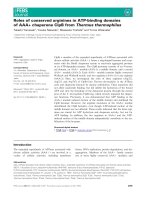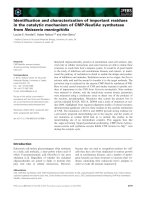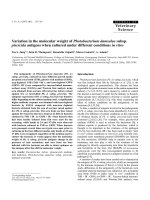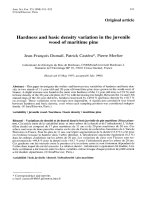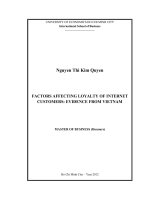Geographical variation in morphological leaf traits of Huperzia serrata (Lycopodiaceae) from Vietnam
Bạn đang xem bản rút gọn của tài liệu. Xem và tải ngay bản đầy đủ của tài liệu tại đây (377.09 KB, 10 trang )
TAP CHI SINH HOC 2019, 41(4): 101–110
DOI: 10.15625/0866-7160/v41n4.14719
GEOGRAPHICAL VARIATION IN MORPHOLOGICAL LEAF TRAITS
OF Huperzia serrata (Lycopodiaceae) FROM VIETNAM
Nguyen Thi Ai Minh1, Le Ngoc Trieu1, Nong Van Duy2, Tran Van Tien1,*
1
Dalat University
Tay Nguyen Institute for Scientific Research, VAST, Vietnam
2
Received 21 October 2019, accepted 24 December 2019
ABSTRACT
Morphological leaf traits can be used to assess adaptive responses of plants to environmental
conditions. To assess how the representation of Huperzia serrata leaf traits, such as leaf length
(LL), leaf width (LW) and leaf area (LA) response to changes in mean annual temperature
(MAT), sunshine duration (SuH), mean annual precipitation (MAP), air humidity (Hu),
intraspecific variation of the morphological leaf traits of the species was analyzed along a
geographical gradient of Vietnam. The results showed that among the three populations at the
three sites, leaf sizes increased with MAT and MAP.
Keywords: Huperzia serrata, climatic factors, morphological leaf traits, Vietnam.
Citation: Nguyen Thi Ai Minh, Le Ngoc Trieu, Nong Van Duy, Tran Van Tien, 2019. Geographical variation in
morphological leaf traits of Huperzia serrata (Lycopodiaceae) from Vietnam. Tap chi Sinh hoc (Journal of Biology),
41(4): 101–110. />*Corresponding author email:
©2019 Vietnam Academy of Science and Technology (VAST)
101
Nguyen Thi Ai Minh et al.
INTRODUCTION
Plant growth is affected by numerous
environmental factors, including water
shortage and excess, temperature, nutrient
availability, and light (Diaz et al., 1998). The
influence of environmental factors on plant
growth can be either direct, via the impact of
physical conditions on primary growth
processes or indirect due to developmental
adaptation (Choat et al., 2007). Phenotypic
plasticity is a major mode of adaptation in
plants
(Sultan,
1995).
Consequently,
morphological leaf traits could reflect the
adaptation of plants to their environment
(Kessler et al., 2007) as they can influence
fitness of plant (Donovan et al., 2011).
Among environmental conditions, climate,
which is a combination of some important
ecological factors, plays an important role in
adaptations of plants as it creates selection
scenarios (Etterson & Shaw, 2001).
Many studies showed evidence of plastic
response to key ecological factors of several
morphological leaf traits (Arens, 2001;
Donohue et al., 2000; Dudley and Schmitt,
1996; Giełwanowska et al., 2012). However,
most studies of these kinds were conducted
among angiosperms and ferns while fernallies received little attention.
Huperzia serrata (Thunb. ex Murray)
Trevis. is a club moss, which is widely
distributed in temperate and tropical zones
including Chinese, Bhutan, Cambodia, India,
Indonesia, Japan, Korea, Laos, Malaysia,
Myanmar, Nepal, Philippines, Russia, Sri
Lanka, Thailand, Vietnam, Australia, Central
America and Pacific islands (Jaswinder et al.,
2016; Wang et al., 2011). In Vietnam, this
species is only available on high mountains
with altitude from 1000 m to 1500 m,
including Lao Cai, Cao Bang, Quang Tri,
Quang Nam, Khanh Hoa, Lam Dong Province
(BVN Group). Widely distributed capacity of
H. serrata represented evidence of their
adaptive ability to a broad range of local
conditions (Joshi et al., 2001) and provided an
opportunity to analyze phenotypic variation
along large geographical gradients (Villellas
et al., 2014). Phenotypic variation could be
102
reflected in the morphological characters of
the leaves, including width, length and area
(Kessler
et
al.,
2007).
However,
parameterizations of the special variation in
the leaf exchange characteristics within
geographical gradients have not been
evaluated. The focus of this study is to assess
how the representation of H. serrata leaf traits
such as leaf length, leaf width, leaf area
response to changes in climatic factors along a
geographical gradient of Vietnam.
MATERIALS AND METHODS
Study local populations and sampling
Figure 1. Distribution of the 3 sampling sites
(provinces) of H. serrata leaves in Vietnam.
The stars represent the origin growth area of
the species where leaves were collected
Samples were collected at high mountains
in provinces documented to have H. serrata in
Vietnam, including Hoang Lien National Park
(Lao
Cai
Province,
22º408’946’’N;
103º838’908’’E); Ngoc Linh National Reserve
(between Quang Nam and Kon Tum Province,
15º071’650’’N, 107º973’969’’E); and Bidoup
Geographical variation in morphological leaf traits
National Park (Lam Dong Province,
12º100’364’’N, 108º664’431’’E) (Fig. 1).
At each study site, which is distribution
area of each population of H. serrata, 30
samples were randomly collected, from 3 to
10 sites in each population. Each sample had
to have at least two gemmiphore layers and
was restored in a zip bag. Sampled
individuals in the three populations were
signed from HuL21 to HuL50 for Hoang
Lien National Park population (signed as
Hoang Lien population); HuK21 to HuK50
for Ngoc Linh National Reserve population
(signed as Ngoc Linh population) and
HuD21 to HuD50 for Bidoup National Park
population (signed as Bidoup population).
Leaf material
All
measurements
in
analyzing
morphological leaf traits were conducted on
30 individuals in each population and on 90
individuals in total. Using gemmiphore layers
to identify yearly growth boundary of shoots
of each individual (Wang et al., 2011). The
numbers of annual growth shoots in each
population identified by using gemmiphore
layers were recorded (table 1). Accordingly,
the number of shoots growing in 4 years, from
2013 to 2016, was adequate for statistical
analysis. On each annual shoot of each
individual, 3 to 5 undamaged big leaves are
collected, and scanned by flatbed scanner
HP4670. Using scanned photographs to
measure leaf size by ImageJ 1.52b software
(Abramoff et al., 2004). Leaf size measures
collected were leaf length (LL), leaf width
(LW) and leaf area (LA). LA is the most
common metric of leaf size and is defined as
the one-side of an individual leaf, expressed in
mm2; LW is an additional trait of ecological
interest related to leaf size, measured as the
maximum diameter of an imaginary circle that
can be fitted anywhere within a leaf and LL is
blade length of a leaf (Pérez-Harguindeguy et
al., 2013).
Table 1. The number of annual growth shoots in each population identified
by using gemmiphore layers
Year
2009
2010
2011
Hoang
Lien
-
Population
Ngoc
Bidoup
Linh
1
2
5
Year
2012
2013
2014
Hoang
Lien
1
8
21
Climatic variability of populations
Meteorological data were obtained for all
three populations from databases of
meteorological stations closest to the
distributed area of each population, which
were Sapa station (Lao Cai Province), Tra My
station (Quang Nam Province) and Dalat
station (Lam Dong Province). At each station,
mean annual air temperature (MAT), mean
annual precipitation (MAP), annual sunshine
duration (SuH), annual air humidity (H) were
obtained. As leaves were collected on annual
growth shoots in 4 years, from 2013 to 2016,
climatic variables of the three study
populations were calculated on database of the
four years denoted.
Population
Ngoc
Bidoup
Linh
1
8
11
15
22
18
Year
2015
2016
2017
Hoang
Lien
29
30
17
Population
Ngoc
Bidoup
Linh
30
30
30
30
-
Data analysis
Statistical analyses were conducted by
STATGRAPHICS Centurion XV Version
15.1.02 software. First, the difference of leaf
size measures as well as climatic variables
among the three populations were tested and
compared by one-way ANOVA and Least
Significant Difference (LSD) to determine the
changing trends of leaf size and climatic
variables along with the latitudinal gradient of
Vietnam. Second, Pearson’s correlation test
was performed to test the relationship between
leaf size measures and climatic variables.
Third, simple regression models were
constructed to describe the linear relationship
between each pair of leaf measure and
climatic variable.
103
Nguyen Thi Ai Minh et al.
Redundancy analysis (RDA) was used to
determine the relative contribution of the
measured climatic factors to leaf trait
measurements of H. serrata. RDA was
performed using XLSTAT software version
2018.1 (Addinsoft, 2018).
Table 2. Climatic variables obtained were mean annual air temperature (MAT), and mean
annual precipitation (MAP), annual sunshine duration (SuH) and annual air humidity (H)
Population
Year
MAT (ºC)
SuH (hours)
MAP (mm)
Hu (%)
2013
14.96
1359.00
2733.50
87.00
2014
15.43
1469.00
2431.60
88.00
Hoang Lien
2015
16.30
1678.00
2491.60
84.42
2016
16.48
1643.00
2516.60
82.75
a
a
a
Average
15.77
1537.25
2543.33
85.54a
2013
24.80
1619.00
4043.00
88.00
2014
25.10
1992.00
3416.00
86.00
Ngoc Linh
2015
25.20
2176.00
4002.00
87.00
2016
25.40
1819.00
5330.00
88.00
c
b
b
Average
25.13
1901.50
4197.75
87.25b
2013
18.40
2071.00
2029.00
85.00
2014
18.20
2109.00
2072.00
80.00
Bidoup
2015
18.50
2244.00
1955.00
84.00
2016
18.50
2109.00
2029.00
86.00
b
b
a
Average
18.39
2133.25
2021.25
83.33a
Notes: MAT (F-ratio = 490.71, P<0.01); SuH (F-ratio = 12.75, P<0.01); MAP (F-ratio = 23.07, P<0.01);
Hu (F-ratio = 3.16, P<0.1).
RESULTS
Climate factors
ANOVA analysis of MAT, SuH, MAP
and Hu showed that those measures were
statiscally significant differences between
sample sites. However, Fisher’s least
significant difference (LSD) procedure
indicated that except for MAT, no significant
differences were found between Hoang Lien
and Bidoup in MAP and Hu; and either Ngoc
Linh and Bidoup in SuH. In the four years, it
was Hoang Lien where had the lowest MAT
(15.77ºC), which was lower than Bidoup
(18.39ºC) and Ngoc Linh (25.13ºC). For SuH,
Bidoup ranked the first (2133.25 hours) while
Ngoc Linh (1901.50 hours) and Hoang Lien
(1537.25 hours) ranked the second and the
third. For MAP, the measure in Ngoc Linh
was the highest (4197.75 mm) which was
much higher than that of Hoang Lien (2543.33
104
mm) and LD (2021.25 mm). For Hu, Fisher’s
LSD procedure proved that there were no
significant differences between Bidoup and
Hoang Lien and either Hoang Lien and Ngoc
Linh. Nevertheless, there was a statistically
significant difference for Hu between Bidoup
and Ngoc Linh. Moreover, it is noticeable that
Hu of the three sites were very high (higher
than 83%). Consequently, it can be suggested
that H.serrata required humid air. In other
words, habitat of H. serata is characterized by
high air humidity.
Leaf variability of populations
Leaf variability of three populations of
Vietnam, as well as climatic variables of the
three study populations was investigated
through statistical analysis of 90 qualitative leaf
morphological traits of the four years. Among
the leaf morphological traits, leaf length, leaf
width and leaf area were observed (table 3).
Geographical variation in morphological leaf traits
Table 3. Leaf size measures of the three local studied populations in four years (2013–2016)
Year
2013
2014
2015
2016
Average
Hoang
Lien
11.09±
2.75
11.67±
3.88
10.67±
3.54
10.36±
3.89
10.77±
3.64a
LL (mm)
Ngoc
Linh
13.49±
3.91
14.35±
4.74
14.36±
4.78
16.43±
5.22
14.86±
4.89b
Bidoup
11.97±
3.61
12.70±
5.16
12.12±
4.36
10.18±
3.26
11.57±
4.23a
Hoang
Lien
2.70±
0.96
2.96±
1.06
2.92±
1.20
2.60±
1.14
2.80±
1.14a
LW (mm)
Ngoc
Linh
3.73±
0.82
3.86±
0.73
3.70±
0.92
3.97±
1.01
3.83±
0.90b
LA (mm2)
Bidoup
2.51±1.24
2.74±1.37
2.61±1.24
2.19±0.99
2.48±1.21a
Hoang
Lien
22.27±
11.30
26.48±
16.65
20.92±
13.01
20.55±
14.19
21.50±
13.33a
Ngoc Linh
Bidoup
33.28±
16.28
31.86±
14.93
30.10±
14.65
40.43±
19.66
33.99±
17.05b
21.05±
14.46
23.46±
17.78
22.08±
16.19
13.45±
8.12
19.39±
14.75a
Notes: LL (F-ratio = 14.92, P<0.01); LW (F-ratio = 56.02, P<0.01); LA (F-ratio = 13.70, P<0.01).
ANOVA revealed that all morphological
leaf traits significantly varied across all the
three populations considered (Table 3). The
proportion of variance of LL, LW and LA
within individuals in the same population
ranged from 33.1% to 36.6%, 23.9–48.7%
and 53.6–80.3%, respectively. Among the
three populations, all three leaf traits
examined in Bidoup population varied the
most while those of Hoang Lien population
varied the least. In other words, Bidoup
population showed higher leaf trait plasticity
than Hoang Lien population and in turn, leaf
traits of Hoang Lien population were more
plastic than those of Ngoc Linh population.
At population level, in the four years,
leaves of Hoang Lien population were the
smallest in 2016 and the biggest in 2014.
Noticeably, MAT and MAP in the habitat of
Hoang Lien population in 2016 were high
(16.48ºC and 2516.6 mm, respectively) and in
2014 were relatively low (15.43ºC and 2431.6
mm). However, Hu of Hoang Lien population
in 2016 was considerably low (82.75%)
compared with that in 2014 (88.00%).
Consequently, it can be implied that growth of
H.serrata leaf was restricted by air humidity.
As for Ngoc Linh population, it is clear
that MAT, MAP and Hu accelerated the
growth of leaf as three leaf measurements in
2016 were the highest, which were agreed
with the highest figure of MAT, MAP and
Hu in the year.
Similar to Hoang Lien population, Hu in
Bidoup population differed moderately (80–
86%). Moreover, MAT and MAP fluctuated
minimally among the four years. However,
different from Hoang Lien population, leaves
in Bidoup population were the smallest in
2016 when Hu peaked in the four years (86%)
and were the largest in 2014 when Hu was the
lowest (80%). A reasonable explanation for
this phenomenon might be wet season
duration. In 2014, Bidoup population habitat
had 7 consecutive months with MAP higher
than 150 mm while in other years, wet season
was suspended by months with MAP lower
than 150 mm. It is 2016 that wet season of
Lam Dong province was split seriously. In
this year, the wet season was interrupted three
times so that the wet period in this year could
not last more than 2 months. In particular, wet
months included April, June and July,
September and October, and December.
At species level, the mean LL ranged from
10.77 mm (Hoang Lien population) to 14.86
mm (Ngoc Linh population); the mean LW
ranged from 2.48 mm (Bidoup pop.) to 3.83
mm (Ngoc Linh population); whereas the
mean LA ranged from 19.39 mm2 (Bidoup
population) to 33.99 mm2 (Ngoc Linh pop.).
Ngoc Linh pop. exhibited the highest LL, LW
and LA, whereas Hoang Lien and Bidoup
populations did the lowest. H. serrata grew in
Hoang Lien with the lowest MAT (15.77ºC)
had the shortest leaves while those grew in
Ngoc Linh with the highest MAT (25.13ºC)
had the longest ones.
Different from LL, LW and LA of the
three populations were consistent with MAP,
especially MAP in rain season. As for LW,
this measurement gradually increased from
105
Nguyen Thi Ai Minh et al.
Bidoup population to Hoang Lien and Ngoc
Linh populations (2.5 mm, 2.8 mm, 3.8 mm,
respectively).
Those
figures
were
corresponding with MAP (2021.25 mm,
2543.33 mm, 4197.75 mm, respectively) as
well as MAP per month in rain season in the
three sites (253.3 mm, 335.4 mm, 544.7 mm,
respectively).
Similar to LW, LA also gradually
increased from Bidoup population to Hoang
Lien population and Ngoc Linh population
(21.0 mm2, 22.3 mm2, 35.3 mm2, respectively)
which were corresponding with MAP
(2021.25 mm, 2543.33 mm, 4197.75 mm,
respectively) as well as MAP per month in
rain season in the three sites (253.3 mm, 335.4
mm, 544.7 mm, respectively). As expected,
the result showed that both MAP and MAT
affected leaf size of H. serrata. MAT had
strong effect on LL while MAP was the factor
that influenced LW and LA.
Among the three populations, Ngoc Linh
population had the biggest leaves because the
population is distributed in the north central
part, which has monsoon tropical climate with
cool winter and summer-autumn-winter rains
and common cloudiness, the MAT is higher
(Table 2). It is recognized that the trend of H.
serrata species grown in regions with higher
MAP and MAT had higher leaf length as well
as leaf width and leaf area.
Multiple variable analysis result revealed
that the mean LL, LW, and LA of H. serrata
leaves had a significantly positive linear
relationship with MAT (r = 0.8663, P =
0.0003; r = 0.8466, P = 0.0005; r = 0.7704, R
= 0.0034, respectively) and MAP (r = 0.8384,
P = 0.0007; r = 0.8997, P = 0.0001; r = 0.9039,
R = 0.0001, respectively). The linear models
of MAT explain 75% of leaf length variability,
72% that of leaf width and 59% that of leaf
area (Fig. 2). As for MAP, the figures were
70%, 81% and 82%, respectively (Fig. 2).
Figure 2. Relationships between morphological leaf trait of leaf length (LL), leaf width (LW),
and leaf area (LA) and the climatic factors of mean annual temperature (MAT)
and mean annual precipitation (MAP) in three sampling sites across Vietnam.
Each square represents 1 of the 12 values of morphological leaf traits measured
in the 3 sampling sites in the four years (2013–2016)
106
Geographical variation in morphological leaf traits
Figure 3. Correlation coefficients between leaf traits of three H. serrata populations and
climatic factors. X- climatic factors, Y- Leaf trait measurements
Leaf traits of the three H. serrata
populations from Vietnam were influenced
by the following climatic factors: MAT,
MAP, SuH and Hu (Fig. 3). Correlation
analyses proved that there were positive
(MAT, MAP) and negative (SuH and Hu)
correlations between leaf traits of H.serrata
populations and climatic factors (Fig. 3).
However, of the four climatic variables, only
MAT and MAP significantly correlated with
leaf trait measurement according to multiple
variable analyses. RDA showed that the four
climate environmental variables (MAT, MAP,
SuH and Hu) together explained 84.05% of
the total variation in the data, and with figure
3 was explaining 99.08% and 0.9% of the
total variation. This result indicates that
some other climatic factors that were not
considered in this study also contribute to the
unexplained variation (Huang et al., 2016)
and MAT and MAP were the major factors
that affected leaf traits.
DISCUSSION
The relationships between morphological
leaf traits and climatic conditions have been
emphasized for at least a century (Wright et
al., 2004). Climatic parameters frequently
used in studies dealing with the relationship
with leaf size and shape were MAT, MAP and
CO2 or temperature- and precipitation-related
parameters (Traiser et al., 2005). Those
parameters were major limiting factors for the
distribution of plants (Traiser et al. 2005).
Leaves vary tremendously in their size
(Sack et al., 2003) and results of
experimental studies as well as direct
sampling of leaves in the field studies proved
that temperature and rainfall had great
impact on leaf size (Flann et al., 2002; Li et
al., 2015). Results of this study showed that
the size of leaves was strongly linearly
related to temperature and rainfall (Fig. 2).
There are biological bases for these
relationships (Field et al., 2005; Royer and
Wilf, 2006; Lawren and Sack, 2013; Traiser
et al., 2005). Plant growing at the sites which
have dry and cold climate tended to have
smaller leaves to reduce evaporation while
larger leave were more common in more
humid areas (Li et al., 2015). For that reason,
LA of H.serrata in Bidoup which had dry
and cold climate (MAP = 2021.25 mm and
MAT = 18.39ºC) was the lowest (LA = 19.39
mm2) while that of Hoang Lien which had
much colder climate (MAT = 15.77ºC) but
more humid (MAP = 2543.33 mm) was
higher. However, LA of H.serrata in a site
warm and humid like Ngoc Linh (MAT =
25.13ºC, MAP = 4197.75 mm) was the
highest (LA = 33.99 mm2).
107
Nguyen Thi Ai Minh et al.
Not only the MAT and MAP were
climatic conditions that created selection
pressure on LA but also high-radiation and air
humidity (Dunbar‐Co et al., 2009; PérezHarguindeguy et al., 2013). In particular,
high-radiation tended to select for relative
small leaves (Pérez-Harguindeguy et al., 2013;
Uhl, Mosbrugger, 1999) to prevent
overheating and confer a benefit in energy
and/ or carbon balance (Vogel, 1968). Besides,
leaf area correlated positively with minimum
relative humidity (Dunbar‐Co et al., 2009).
Consequently, those climate factors could
contribute in small leaves of Bidoup where
had the highest annual sunshine duration
(2133.25 hours) and the lowest annual air
humidity (83.33%). Otherwise, the largest
leaves of Ngoc Linh could be due to the lower
annual sunshine duration (1901.50 hours) as
well as the highest annual air humidity
(87.25%). However, unlike MAT and MAP,
Pearson’s correlation test results did not show
the significant correlations between LA and
SuH (r = -0.1178, P = 0.7153) or LA and Hu
(r = 0.5213, P = 0.0822).
The decrease of leaf width was consistent
with temperature (Ezcurra et al., 1997).
Therefore, the fluctuation of leaf width each
year in each population showed a contrary
trend with the fluctuation of average air
temperature of each year. Besides, the trend
mentioned above could be applied for the
average measures of the four years. In
particular, Hoang Lien distributing in cooler
area (15.77ºC) had leaf width higher than that
of Bidoup distributing in warmer area
(18.39ºC). There was an exception in Ngoc
Linh where had highest leaf width (3.83 mm)
distributing in warmest area (25.13ºC). As
Ngoc Linh has the highest rainfall over the
four years (MAP = 4197.75 mm), the
promoting effect on leaf spreading of rainfall
might overcame constraining effect of
temperature. In conclusion, both temperature
and rainfall had effect on leaf width of H.
serrata. However, the effect of the two
climatic factors had contrary trends.
An evolutionary trade-off between the
antagonistic
demand
of
maximizing
108
photosynthesis
relative
to
structural
investment has yield a great diversity in the
morphological character of leaves (Brodribb
et al., 2010; Donovan et al., 2011). There
were strong positive correlations between
morphological leaf traits and temperature as
well as rainfall.
CONCLUSION
Most of recorded morphological leaf traits
were reveals that environment conditions have
had the most important impacts on the
favorable growing conditions. In this study,
Quang Nam population, which is high MAT
and MAP that exhibited increased growth (LL,
LW and LA). Thus, as suggested that by leaf
sizes increased with MAT and MAP.
Acknowledgements:
This
study
was
supported by the National Foundation for
Science
&
Technology
Development
(NAFOSTED) under grant no. 106-NN.032014.17. We also thank Mr. Nguyen Xuan
Tung of Mangrove Ecosystem Research
Centre
(MERC)
Hanoi National University of Education
(HNUE) for helping collecting samples and
Mr. Nguyen Hoang Phong of Biology Faculty,
Dalat University for helping preliminary
accessing samples in laboratory.
REFERENCES
Abramoff M. D., Magalhães P., Ram J.,
Sunanda J., 2004. Image processing with
ImageJ. Biophotonics International, 11(7):
36–43.
Addinsoft., 2018. XLSTAT statistical and
data analysis solution. New York, USA.
. (Version 2018.1).
Arens N. C., 2001. Variation in performance
of the tree fern Cyathea caracasana
(Cyatheaceae) across a successional
mosaic in an Andean cloud forest.
American Journal of Botany, 88(3): 545–
551. />Brodribb T. J., Feild T. S., Sack L., 2010.
Viewing leaf structure and evolution from
a hydraulic perspective. Functional Plant
Biology,
37(6):
488–498.
/>
Geographical variation in morphological leaf traits
Choat B., Sack L., Holbrook N. M., 2007.
Diversity of hydraulic traits in nine Cordia
species growing in tropical forests with
contrasting precipitation. New Phytologist,
175(4):
686–698.
/>Diaz S., Cabido M., Casanoves F., 1998. Plant
functional traits and environmental filters
at a regional scale. Journal of Vegetation
Science,
9(1):
113–122.
/>Donohue K., Messiqua D., Pyle H. E.,
Heschel M. S., Schmitt J., 2000. Evidence
of adaptive divergence in plasticity:
Density- and site-dependent selection on
shade-avoidance responses in Impatiens
capensis. Evolution, 54(6): 1956–1968.
/>Donovan L. A., Maherali H., Caruso C. M.,
Huber H., de Kroon H., 2011. The
evolution of the worldwide leaf economics
spectrum. Trends in Ecology & Evolution,
26(2):
88–95.
/>Dudley S. A., Schmitt J., 1996. Testing the
Adaptive Plasticity Hypothesis: DensityDependent Selection on Manipulated
Stem Length in Impatiens capensis. The
American Naturalist, 147(3): 445–465.
/>Dunbar C. S., Sporck M. J., Sack L., 2009.
Leaf Trait Diversification and Design in
Seven Rare Taxa of the Hawaiian
Plantago Radiation. International Journal
of Plant Sciences, 170(1): 61–75.
/>Etterson J. R., Shaw R. G., 2001. Constraint
to Adaptive Evolution in Response to
Global Warming. Science, 294(5540):
151–154.
/>Ezcurra C., Ruggiero A., Crisci J. V., 1997.
Phylogeny
of
Chuquiraga
Sect.
Acanthophyllae
(AsteraceaeBarnadesioideae), and the Evolution of its
Leaf Morphology in Relation to Climate.
Systematic Botany,
22(1): 151–163.
/>Feild T. S., Sage T. L., Czerniak C., Iles W. J.
D., 2005. Hydathodal leaf teeth of
Chloranthus japonicus (Chloranthaceae)
prevent guttation-induced flooding of the
mesophyll. Plant, Cell & Environment,
28(9):
1179–1190.
/>Flann C., Ladiges P. Y., Walsh N. G., 2002.
Morphological
variation
in
Leptorhynchos squamatus (Gnaphalieae:
Asteraceae).
Australian
Systematic
Botany, 15(2): 205–219.
Giełwanowska I., Szczuka E., Bednara J.,
Górecki R., 2005. Anatomical Features
and Ultrastructure of Deschampsia
antarctica
(Poaceae)
Leaves
from
Different Growing Habitats. Annals of
Botany,
96(6):
1109–1119.
/>Huang W., Zhao X., Zhao X., Li Y., Lian J.,
2016. Effects of environmental factors on
genetic diversity of Caragana microphylla
in Horqin Sandy Land, northeast China.
Ecology and Evolution, 6(22): 8256–8266.
/>Jaswinder K., Rajmeet S., Gurinder S.,
Harpreet K., Jasvir K., Manpreet K,
Jaspreet K., 2016. A Systematic Review
on Huperzia serrata. International
Journal
of
Pharmacognosy
and
Phytochemical Research, 8(8): 1250–1255.
Joshi J., Schmid B., Caldeira M. C.,
Dimitrakopoulos P. G., Good J., Harris R.,
Lawton J. H., 2001. Local adaptation
enhances performance of common plant
species. Ecology Letters, 4(6): 536–544.
/>Kessler M., Siorak Y., Wunderlich M.,
Wegner
C.,
2007.
Patterns
of
morphological
leaf
traits
among
pteridophytes along humidity and
109
Nguyen Thi Ai Minh et al.
temperature gradients in the Bolivian
Andes. Functional Plant Biology, 34(11):
963–971. />Li X., Li Y., Zhang Z., Li X., 2015. Influences
of Environmental Factors on Leaf
Morphology of Chinese Jujubes. PLOS
ONE, 10(5): 1-16. />journal.pone.0127825.
Marcysiak K., 2012. Calculated characters of
leaves are independent on environmental
conditions in Salix herbacea (Salicaceae)
and Betula nana (Betulaceae). Acta
Societatis Botanicorum Poloniae, 81(3):
153158. />Pérez-Harguindeguy N., Díaz S., Garnier E.,
Lavorel S., Poorter H., Jaureguiberry P.,
Cornelissen J. H. C., 2013. New handbook
for standardised measurement of plant
functional traits worldwide. Australian
Journal of Botany, 61(3): 167–234.
/>Royer D. L., Wilf P., 2006. Why Do Toothed
Leaves Correlate with Cold Climates? Gas
Exchange at Leaf Margins Provides New
Insights into a Classic Paleotemperature
Proxy. International Journal of Plant
Sciences,
167(1):
11–18.
/>Sack L., Cowan P. D., Jaikumar N., Holbrook
N. M., 2003. The ‘hydrology’ of leaves:
Co-ordination of structure and function in
temperate woody species. Plant, Cell &
Environment,
26(8): 1343–1356.
/>Sack L., 2013. Holding a Leaf Up to the Light.
BioScience,
63(12):
981–982.
/>Sultan S. E., 1995. Phenotypic plasticity and
plant
adaptation.
Acta
Botanica
Neerlandica, 44(4): 363–383.
110
Traiser C., Klotz S., Uhl D., Mosbrugger V.,
2005. Environmental signals from leaves
– a physiognomic analysis of European
vegetation. New Phytologist, 166(2): 465–
484.
/>Uhl D., Mosbrugger V., 1999. Leaf venation
density as a climate and environmental
proxy: A critical review and new data.
Palaeogeography,
Palaeoclimatology,
Palaeoecology,
149(1):
15–26.
/>Vietnam Plant Data Center (BVNGroup).
(n.d.). Retrieved April 25, 2016. Huperzia
serrata.
website:
/>edir&v=Huperzia%20serrata&list=species.
Villellas J., Berjano R., Terrab A., García M.
B., 2014. Divergence between phenotypic
and genetic variation within populations
of a common herb across Europe.
Ecosphere,
5(5):
1–14.
/>Vogel S., 1968. “Sun Leaves” and “Shade
Leaves”: Differences in Convective Heat
Dissipation. Ecology, 49(6): 1203–1204.
/>Wang D. L. , Qi Y. D., Feng J. D., Wei J. H.,
2011. An Efficient Regeneration Pattern
via Gemmae for Huperzia serrata (Thunb.
Ex Murray) Trev. In Hainan Province,
China. American Fern Journal, 101(3):
182–192.
/>Wright I. J., Reich P. B., Westoby M.,
Ackerly D. D., Baruch Z., Bongers F.,
Villar R., 2004. The worldwide leaf
economics spectrum. Nature, 428(6985):
821–827.
/>nature02403.
